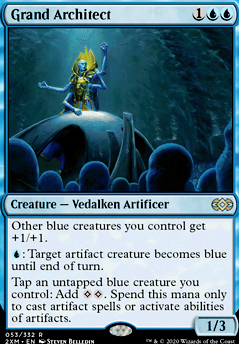Ok so I was playing against this guy on untap. I lost game 1 against him because... well he exploded.
So we go to Game 2 and I am on the play. My hand is
Island,
Flooded Strand,
Grand Architect,
Painter's Servant,
Myr Superion,
Myr Superion,
Aether Vial. My opponent opens with a Gemstone Cavern turn 0 removing
Eldrazi Obligator
because, you know, of course he would. For the record, he did not see any of my superions game 1.
Turn 1 I play
Island, play
Aether Vial, and pass. He plays
Cavern of Souls naming you know darn well what, and plays a
Chalice of the Void on 1. I guess he didn't like me having
Path to Exile since I used it on him game 1.
Turn 2 I draw
Polluted Delta. Now at this point, I could play and crack a fetch land to play the
Painter's Servant, but my opponent has no eldrazi lands out and my
Aether Vial will tick up next turn to let me play him at instant speed, so I just play the
Polluted Delta and pass. He topdecks
Eye of Ugin and proceeds to drop three
Eldrazi Mimics AND a
Ruination Guide
. That's every card he has in hand for the record. I guess the
Eye of Ugin was a topdeck, because that could have been his turn 1 play instead of turn 2. End of his turn I crack the
Polluted Delta and go get a
Hallowed Fountain tapped.
Turn 3, my vial ticks up to two charge counters. At this point, I am ready to scare the living !@#$ out of this eldrazi player. I draw a third
Myr Superion. I play and crack my
Flooded Strand getting an
Island, tap the
Aether Vial to bring in
Painter's Servant and name blue. I then spend all three of my mana to play
Grand Architect. Bear in mind, ALL of my creatures are blue now. I tap GA to make 2 colorless and summon the first
Myr Superion. I tap
Painter's Servant to summon the second. I tap a
Myr Superion to summon the third. At this point my opponent says something in chat along the lines of "Cool it bro, I'm supposed to be the one playing the explosive deck!" I pass the turn and he reveals a
Reality Smasher, turning all 3 of the mimics into 6/5's. He can't play the smasher because his lands only make a total of 4 mana, but
Painter's Servant is also stopping
Eye of Ugin from working, so my opponent only has access to 2 mana. He looks at his mimics which are 6/5's for the turn, looks at my two untapped superions, and swings. Bear in mind, all of those superions are blue thanks to
Painter's Servant and GA is providing a lord effect to blue creatures. The superions are 6/7's right now, not 5/6's, and my opponent missed this fact. I freebie block two mimics and take 6. At this point, I'm at 12 but I don't give a crap. I have 3 6/7's and two 2/4's on turn 3! My opponent, having just thrown away two mimics by mistake, concedes and writes "Dude, I thought you were supposed to make infinite mana with that deck! That's not infinite mana! What it is, is more busted than what my deck does!"
I'm sharing this not because this is a normal thing, but because it is so abnormal yet so hilariously powerful. Draws like this can only ever happen against Eldrazi Aggro because I don't board Painter's Servant in against any other deck (I don't even run it sideboard anymore thanks to dredge), but dang is that combo fun! I played against an eldrazi deck that swung for 18 on turn 3 with 3 6/5's, and I already had such a powerful board that I just freebie'd him into conceding! It may not be the most powerful nor the most busted deck out there, but dang do I love this deck!







